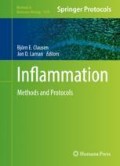Abstract
Next-generation sequencing (NGS) techniques provide unique prospects for in-depth transcriptome analyses. Nevertheless, the emerging and still growing knowledge about the large diversity and heterogeneity of cells that participate in immunological responses in a tissue- and micromilieu-specific manner calls for advanced isolation and sequencing methods for the accurate quantification of gene expression in small cell populations and even individual cells from any organ or tissue. One of the major limitations in performing transcriptome analyses of rare cell populations was and still is quality and quantity of RNA that often limits analyses of complex mixtures of immune cell populations. Here, we describe a protocol to isolate rare T cell populations from the lung and in particular the subsequent methods to isolate high-grade RNA in order to perform NGS-based transcriptome analyses.
Access this chapter
Tax calculation will be finalised at checkout
Purchases are for personal use only
References
Mosmann TR, Cherwinski H, Bond MW, Giedlin MA, Coffman RL (1986) Two types of murine helper T cell clone. I. Definition according to profiles of lymphokine activities and secreted proteins. J Immunol 136:2348–2357
Abbas AK, Murphy KM, Sher A (1996) Functional diversity of helper T lymphocytes. Nature 383:787–793
Dong C, Flavell RA (2000) Control of T helper cell differentiation—in search of master genes. Sci STKE 2000:pe1
Stockinger B, Veldhoen M, Martin B (2007) Th17 T cells: linking innate and adaptive immunity. Semin Immunol 19:353–361
Miossec P, Korn T, Kuchroo VK (2009) Interleukin-17 and type 17 helper T cells. N Engl J Med 361:888–898
Eyerich K, Pennino D, Scarponi C, Foerster S, Nasorri F, Behrendt H, Ring J, Traidl-Hoffmann C, Albanesi C, Cavani A (2009) IL-17 in atopic eczema: linking allergen-specific adaptive and microbial-triggered innate immune response. J Allergy Clin Immunol 123:59–66.e4
Veldhoen M, Uyttenhove C, Van Snick J, Helmby H, Westendorf A, Buer J, Martin B, Wilhelm C, Stockinger B (2008) Transforming growth factor-beta “reprograms” the differentiation of T helper 2 cells and promotes an interleukin 9-producing subset. Nat Immunol 9:1341–1346
Dardalhon V, Awasthi A, Kwon H, Galileos G, Gao W, Sobel RA, Mitsdoerffer M, Strom TB, Elyaman W, Ho I-C, Khoury S, Oukka M, Kuchroo VK (2008) IL-4 inhibits TGF-beta-induced Foxp3+ T cells, and together with TGF-beta, generates IL-9+ IL-10+ Foxp3(−) effector T cells. Nat Immunol 9:1347–1355
Shevach EM (2002) CD4+ CD25+ suppressor T cells: more questions than answers. Nat Rev Immunol 2:389–400
Sakaguchi S, Yamaguchi T, Nomura T, Ono M (2008) Regulatory T cells and immune tolerance. Cell 133:775–787
Josefowicz SZ, Rudensky A (2009) Control of regulatory T cell lineage commitment and maintenance. Immunity 30:616–625
Burzyn D, Kuswanto W, Kolodin D, Shadrach JL, Cerletti M, Jang Y, Sefik E, Tan TG, Wagers AJ, Benoist C, Mathis D (2013) A special population of regulatory T cells potentiates muscle repair. Cell 155:1282–1295
Ulges A, Klein M, Reuter S, Gerlitzki B, Hoffmann M, Grebe N, Staudt V, Stergiou N, Bohn T, Brühl T-J, Muth S, Yurugi H, Rajalingam K, Bellinghausen I, Tuettenberg A, Hahn S, Reißig S, Haben I, Zipp F, Waisman A, Probst H-C, Beilhack A, Buchou T, Filhol-Cochet O, Boldyreff B, Breloer M, Jonuleit H, Schild H, Schmitt E, Bopp T (2015) Protein kinase CK2 enables regulatory T cells to suppress excessive TH2 responses in vivo. Nat Immunol 16:267–275
Gray DHD, Liston A (2014) Uhrf to Treg cells: reinforcing the mucosal peacekeepers. Nat Immunol 15:533–534
Thome JJC, Farber DL (2015) Emerging concepts in tissue-resident T cells: lessons from humans. Trends Immunol 36:428–435
Picelli S, Faridani OR, Björklund ÅK, Winberg G, Sagasser S, Sandberg R (2014) Full-length RNA-seq from single cells using Smart-seq2. Nat Protoc 9:171–181
Picelli S, Björklund ÅK, Faridani OR, Sagasser S, Winberg G, Sandberg R (2013) Smart-seq2 for sensitive full-length transcriptome profiling in single cells. Nat Methods 10:1096–1098
Bopp T, Dehzad N, Reuter S, Klein M, Ullrich N, Stassen M, Schild H, Buhl R, Schmitt E, Taube C (2009) Inhibition of cAMP degradation improves regulatory T cell-mediated suppression. J Immunol 182:4017–4024
Schroeder A, Mueller O, Stocker S, Salowsky R, Leiber M, Gassmann M, Lightfoot S, Menzel W, Granzow M, Ragg T (2006) The RIN: an RNA integrity number for assigning integrity values to RNA measurements. BMC Mol Biol 7:3
Lahl K, Loddenkemper C, Drouin C, Freyer J, Arnason J, Eberl G, Hamann A, Wagner H, Huehn J, Sparwasser T (2007) Selective depletion of Foxp3+ regulatory T cells induces a scurfy-like disease. J Exp Med 204:57–63
Author information
Authors and Affiliations
Corresponding author
Editor information
Editors and Affiliations
Rights and permissions
Copyright information
© 2017 Springer Science+Business Media LLC
About this protocol
Cite this protocol
Ulges, A., Schmitt, E., Bopp, T., Klein, M. (2017). Messenger RNA Sequencing of Rare Cell Populations in the Lung and Lung-Draining Lymph Nodes. In: Clausen, B., Laman, J. (eds) Inflammation. Methods in Molecular Biology, vol 1559. Humana Press, New York, NY. https://doi.org/10.1007/978-1-4939-6786-5_14
Download citation
DOI: https://doi.org/10.1007/978-1-4939-6786-5_14
Published:
Publisher Name: Humana Press, New York, NY
Print ISBN: 978-1-4939-6784-1
Online ISBN: 978-1-4939-6786-5
eBook Packages: Springer Protocols

